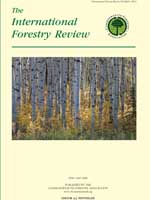A breeding program aimed at increasing economic value of whitewood plantations in Vanuatu and conserving declining genetic resources will take direction from the results of this study. Genetic parameters for stem diameter breast height over bark (DBHOB), straightness and branching were estimated in an 11.4-year-old whitewood breeding population on Espiritu Santo Island. Wood density variation in one subpopulation was also studied. Trees with the fastest growth and best form were from Espiritu Santo. Growth and form trait heritability estimates ( = 0.10–0.16) were low to moderate, with moderate phenotypic variation (CVP = 17–36%). DBHOB at 11.4-years and 4-years were very closely genetically correlated (rA = 1.00 ± 0.17). Mean unextracted wood basic density at breast height was 330 (SD±21) kg/m3, or similar to mature-tree densities. Economic gain in growth traits can be expected from a recurrent selection and breeding program given the heritable genetic variation indicated in this study. Conserving genetic diversity in this species is a high priority.
= 0.10–0.16) were low to moderate, with moderate phenotypic variation (CVP = 17–36%). DBHOB at 11.4-years and 4-years were very closely genetically correlated (rA = 1.00 ± 0.17). Mean unextracted wood basic density at breast height was 330 (SD±21) kg/m3, or similar to mature-tree densities. Economic gain in growth traits can be expected from a recurrent selection and breeding program given the heritable genetic variation indicated in this study. Conserving genetic diversity in this species is a high priority.
How to translate text using browser tools
1 December 2012
Variation in Growth Traits and Wood Density in Whitewood (Endospermum medullosum): a Major Timber Species in Vanuatu
J. Doran,
D. Bush,
T. Page,
K. Glencross,
M. Sethy,
I. Viji
ACCESS THE FULL ARTICLE

International Forestry Review
Vol. 14 • No. 4
December 2012
Vol. 14 • No. 4
December 2012
diameter
form
Genetic correlations
height
heritabilities
volume




